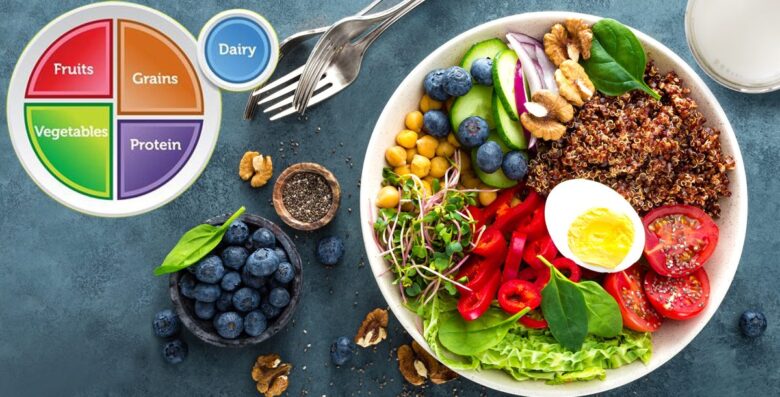In a world filled with quick snacks, fast food, and busy schedules, eating healthy can feel complicated. But nourishing your body doesn’t have to mean strict diets or cutting out your favorite foods. The real secret lies in learning how to build balanced meals — meals that give your body the nutrients it needs to feel energized, satisfied, and strong. A balanced plate is not just about calories; it’s about combining the right foods in the right proportions to support overall wellness.
In this article, you’ll learn how to create balanced meals that fit your lifestyle, improve your health, and make eating enjoyable again.
Why Balanced Meals Matter
A balanced meal provides your body with a mix of carbohydrates, proteins, fats, vitamins, and minerals — the essential building blocks of good health. When you eat in balance, you maintain stable energy levels, manage your weight more effectively, and reduce your risk of chronic diseases like diabetes, heart problems, and obesity.
Unbalanced eating, on the other hand, can lead to fatigue, mood swings, nutrient deficiencies, and overeating. Think of your meals as fuel — when your body gets the right combination of nutrients, it runs efficiently. Balanced meals also keep you fuller longer, making it easier to resist unhealthy snacks and late-night cravings.
The Core Components of a Balanced Meal
Building balanced meals starts with understanding what your plate should include. The goal is to have a little of everything your body needs, without overdoing any one component.
1. Carbohydrates:
Carbs are your body’s main energy source. Choose complex carbohydrates like whole grains, quinoa, brown rice, oats, or sweet potatoes instead of refined ones like white bread or pastries. These release energy slowly and keep you full longer.
2. Protein:
Protein helps repair tissues, supports muscle health, and keeps your metabolism active. Include lean sources like chicken, fish, eggs, beans, tofu, or lentils in every meal.
3. Healthy Fats:
Fats are often misunderstood, but they’re essential for brain health and hormone balance. Opt for good fats from sources like avocados, olive oil, nuts, and seeds rather than fried or processed foods.
4. Fiber:
Fiber aids digestion and helps control blood sugar. Fill half your plate with vegetables and fruits — the more color, the better. Each color provides unique antioxidants and nutrients that promote overall health.
5. Hydration:
While not part of the plate itself, water is crucial for digestion, nutrient absorption, and energy. Drink plenty of water throughout the day to support your body’s natural balance.
How to Build a Balanced Plate
The easiest way to visualize a balanced meal is to think of your plate as divided into sections:
- Half filled with vegetables and fruits.
- One-quarter with lean protein.
- One-quarter with complex carbohydrates.
Add a small serving of healthy fat like olive oil or a few nuts to complete the meal. This simple ratio keeps nutrients in check while ensuring your meal is both satisfying and nutritious.
For example:
- A plate with grilled salmon, brown rice, and roasted vegetables.
- A bowl with quinoa, chickpeas, mixed greens, avocado, and olive oil dressing.
- A breakfast plate with oatmeal, Greek yogurt, berries, and chia seeds.
These combinations give you a steady energy supply and prevent the mid-day crashes caused by sugar-heavy meals.
Smart Eating Throughout the Day
Creating balanced meals isn’t just about what you eat at lunch or dinner — it’s about consistency. Spacing out your meals and snacks properly helps maintain stable blood sugar levels and prevents overeating later in the day.
Start your morning with a protein-rich breakfast like eggs and whole-grain toast. For lunch, combine lean protein with fiber and whole grains. Dinner should be lighter but still balanced — grilled vegetables, a lean protein, and healthy fat.
If you get hungry between meals, choose nutrient-dense snacks like fruit with nuts, yogurt with seeds, or whole-grain crackers with hummus. These keep your metabolism active and your energy steady.
Plan Ahead to Make Healthy Eating Easier
One of the biggest barriers to balanced eating is lack of preparation. When you’re hungry and pressed for time, it’s easy to grab whatever’s convenient — usually processed food. Meal planning helps you stay on track and ensures that healthy options are always available.
Set aside one day a week to prepare ingredients like cooked grains, roasted vegetables, and lean proteins. Store them in containers for quick access. You can mix and match throughout the week to create delicious, balanced meals in minutes.
Having healthy staples at home — like eggs, frozen vegetables, canned beans, and whole grains — also makes it easier to throw together a quick, nutritious meal without stress.
Listen to Your Body and Eat Mindfully
Building balanced meals isn’t only about nutrition; it’s also about mindfulness. Pay attention to how food makes you feel. Eat slowly, savoring each bite, and stop when you feel comfortably full. When you eat mindfully, you naturally make better food choices and enjoy your meals more.
Avoid distractions like phones or TV during meals — being present helps your body recognize fullness cues and improves digestion. Over time, mindful eating can help repair your relationship with food and promote a healthier lifestyle overall.
Common Mistakes to Avoid
Even with good intentions, some habits can throw your diet off balance. Avoid skipping meals, as it can slow your metabolism and lead to overeating later. Also, don’t rely too heavily on processed “health” foods like protein bars or smoothies — many contain hidden sugars and additives.
Finally, be cautious with portion sizes. Even healthy foods can cause weight gain if eaten in excess. Focus on quality and moderation rather than restriction or calorie counting.
Frequently Asked Questions (FAQs)
Q1: How can I tell if my meals are balanced?
If your plate includes a mix of protein, complex carbs, vegetables, and healthy fats — and you feel energized instead of sluggish after eating — you’re likely eating in balance.
Q2: Do I need to count calories to eat balanced meals?
Not necessarily. Focusing on whole, nutrient-dense foods and proper portion sizes is more effective and sustainable than obsessing over calorie numbers.
Q3: Can I still enjoy my favorite foods?
Absolutely. Balance doesn’t mean restriction. Enjoy your favorites in moderation and pair them with healthier options to maintain overall nutrition.
Q4: What’s the best way to get enough vegetables daily?
Add them to every meal — in omelets, soups, sandwiches, or smoothies. The more variety, the better. Aim for at least five servings of fruits and vegetables a day.
Q5: How do balanced meals help with weight management?
They prevent overeating by keeping you full longer and stabilizing your blood sugar. Balanced meals also support metabolism and reduce cravings for junk food.
Conclusion
Building balanced meals is one of the most effective and sustainable ways to improve your health and energy. It’s not about dieting or restriction — it’s about nourishment, consistency, and mindfulness. When you fuel your body with the right mix of nutrients, you feel more energized, focused, and confident in your choices.
Start small by adjusting one meal at a time, and soon balanced eating will become second nature. Remember, every plate you build is an opportunity to invest in your long-term wellness. With mindful planning and smart food combinations, you can create a healthier lifestyle that lasts.




